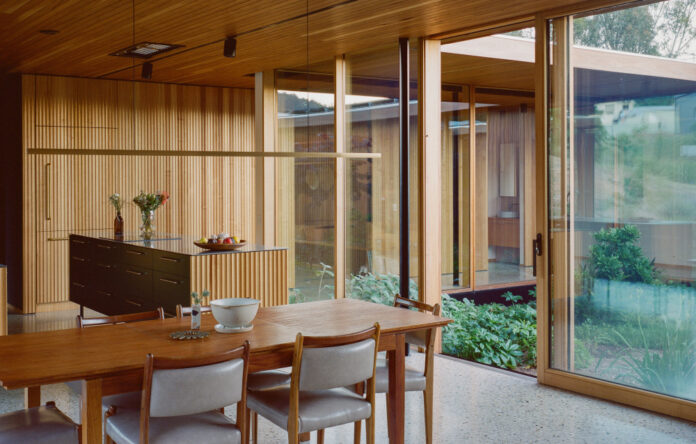[ad_1]
A Modern Court House For Yackandandah
Architecture

Court House is a newly-built home in Yackandandah, a small town in north-east Victoria. Photography – Rory Gardiner

Balancing council expectations and their own vision for the project, Archier has designed a house that positively contributes to Yackandandah’s built environment while reflecting the owners’ values. Photography – Rory Gardiner

The public position of the site called for a house that would be appreciated by the community while providing privacy to the young family. Photography – Rory Gardiner

The single-level design twists around an internal courtyard, with communal rooms facing the street, and bedrooms at the rear. Photography – Rory Gardiner

Sarah Trotter designed the home’s interior palette, specifying warm materials that weathered well over time. Photography – Rory Gardiner

Communal rooms face the street, with bedrooms at the rear of the home. Photography – Rory Gardiner

Mieczyslaw Gorowski poster. Photography – Rory Gardiner

All rooms look out to the central courtyard—serving as its own interior feature—which has been deliberately planted by Julia and her mother, who runs gardening groups in Wodonga, to dramatically change with each season. Photography – Rory Gardiner

It’s a building that seemingly reaches out to the community, rather than attempting to hide away. Photography – Rory Gardiner

Photography – Rory Gardiner

Photography – Rory Gardiner

Photography – Rory Gardiner

The garden was planted according to the micro-environment, created by the undulations of the block, with trees to help ease the very public nature of the site. Photography – Rory Gardiner

Nicknamed Court House, this house is Chris’ gift to his hometown, encompassing his hopes for the future of the town’s built environment. Photography – Rory Gardiner

Photography – Rory Gardiner
Architect Chris Gilbert was born in the local hospital in Yackandandah, a small town in north-east Victoria, with views of Mount Big Ben—a landscape that has shaped him, both physically and mentally, into the person he is today.
As a director of Melbourne-based architecture practice Archier, Chris says there’s no dividing line between the work his studio currently produces, and the area in and around Yackandandah. ‘The former is a direct result of the latter,’ he says. ‘It is a very special place.’
This same appreciation of the town is shared by this project’s client, Julia, who grew up in nearby Wodonga. Julia’s childhood formed the blueprint of how she wanted to raise her daughters, so her family embarked on a tree change from Melbourne, purchasing a block of land next to the former court house in Yackandandah.
Both Archier and Julia wanted the new home to positively contribute to Yackandandah, while reflecting the owners’ values of sustainability, longevity, and connection to the community. The project also needed to contend with council requirements, which emphasised speaking to and preserving the area’s settler history.
The local council’s commitment to the preservation of a questionable colonial history is worth critiquing, says Chris. ‘We disagree that a brief, recent period in time warrants an aesthetic to be applied wholesale to an entire town. Council’s position is repugnant; it compels designers to pay homage to our colonial past while denying new community members an opportunity to contribute their voice through the built environment,’ he says.
‘I was born in this town and would prefer to contribute to a better future.’
As a compromise, Archier’s design focused only on key principles from colonial history they could value; mainly the emphasis on craft and longevity, and using materials from the surrounding area.
The public position of the site called for a house that would be appreciated by the community, while also providing privacy to the young family. The result was a single-level design that twists around an internal courtyard, with communal rooms facing the street, and bedrooms at the rear. It’s a building that seemingly reaches out to the community, rather than attempting to hide away.
Sarah Trotter designed the home’s interior palette, specifying warm materials that would weather well over time. The concrete edge beams and blade columns were key to anchoring the building in place, with textures and colours found locally.
All rooms look out to the central courtyard—serving as its own interior feature—which has been deliberately planted by Julia and her mother, who runs gardening groups in Wodonga, to dramatically change with each season. Their planting schemes responds to the micro-environment created by the undulations of the block, with trees to help ease the very public nature of the site.
Nicknamed Court House, this house is Chris’ gift to his hometown, encompassing his hopes for the future of Yackandandah’s built environment.
[ad_2]
thedesignfiles.net










